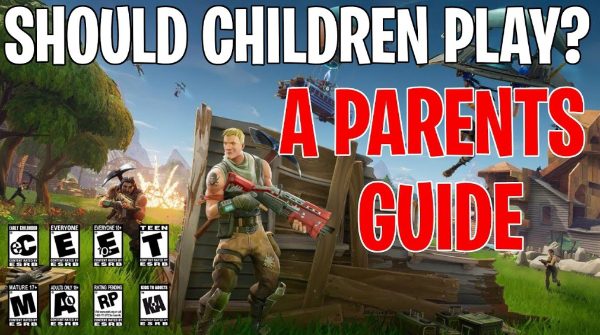The fortnite age rating can assist parents in making a decision on whether their kids should play the game or not. Fortnite is among the most successful video games in the world. There are over 400 million registered players in the game. It is played by a number of children, teenagers and adults everyday. Still, parents are interested in knowing what makes it appealing and whether it is acceptable with its far-reaching cultural appeal. Thus, age ratings give families a straight-forward professional advice to abide by. So, this parent’s guide to Fortnite age rating helps guardians decide if they should let their kid play this game.
Why is Fortnite popular despite its age rating?
Fortnite is offered by the Epic Games platform. It is an attempt to make a battle royale and sandbox hybrid at its core. The participants are placed in an open island with 100 participants. The main goal is survival. Players need to collect weapons, erect structures and kill other players until only one team or player is left.
Survival, shooting and building mechanics are combined with the gameplay. Fortnite has colored, cartoon-like graphics, unlike other survival shooters. This renders it visually light in contrast to adult shooters with blood graphics. Although the focus is on combat, the visuals in the game are made to appeal to the young audience.



There are a number of reasons why Fortnite has been so popular among kids and adolescents:
- Accessibility: The Battle Royale mode is free to play. Players are able to purchase optional items only with the help of V-Bucks which is the in-game currency.
- Regular updates: Fortnite also has seasonal events, new content, and partnerships with popular franchises like Marvel, Star Wars and major celebrities.
- Social relation: You can add friends, use voice chats and cross platform cooperation. Millions are attracted by the social side of playing together in a four-man team.
- Bright graphics: The visual effect is a combination of cartoon comedy and action motifs, which makes playing the game seem more comfortable.
- Multiplatform compatibility: Fortnite unites console, PC, and mobile gamers, thus, becoming a unifying factor.
The combination brings about advantages and fears among the parents. Although the game encourages collaboration and friendship, its addictive nature and level of combativeness can be a cause of concern to families. Similarly, the game has an age rating that would restrict interest among younger users. However, it is free and a mainstream game, which makes it attractive to underage children.
Different game modes
Fortnite is known for creativity and offers a ton of game modes to help players keep themselves engaged for hours. These modes should be known to parents in order to assess risks more accurately.
1. Battle Royale
Fortnite’s main mode drops 100 players onto an island to battle until one remains. Players gather weapons, build defenses, and survive a shrinking map. The combat is cartoon-like, without blood or gore, but online interaction and competitiveness can expose younger players to strangers, language, and potential cyberbullying.
Examples: Similar in concept to Apex Legends or PUBG, but more child-friendly.
2. Creative Mode
Creative Mode lets players design their own maps, mini-games, or virtual worlds. It encourages imagination, teamwork, and problem-solving instead of fighting. Many parents see it as the safest option since kids can focus on design and creativity. It’s similar to Roblox or Minecraft’s creative building experience.
Examples: Comparable to Roblox or Minecraft Creative Mode, where kids freely build and share their own worlds.
3. Save the World
Save the World is Fortnite’s original cooperative mode. Players team up to fight off computer-controlled zombie-like creatures, collect resources, and build fortifications. It’s paid, less competitive, and focuses on teamwork and strategy rather than player-versus-player combat, making it a calmer and more structured experience for families.
Examples: Similar in tone to Plants vs. Zombies: Garden Warfare or Left 4 Dead, but more cartoon-styled.
4. LEGO Fortnite
LEGO Fortnite combines LEGO’s colorful world with Fortnite’s building and survival gameplay. It emphasizes exploration, creativity, and teamwork, with very mild cartoon combat. Rated PEGI 7, it’s designed for younger players. Families often use it as a child-friendly entry point into Fortnite before trying more intense modes.
Examples: Feels like a blend of LEGO Worlds and Minecraft Legends, emphasizing fun, family-friendly adventure.
Fortnite age rating worldwide
It would be important to go through global age ratings in order to have a complete picture. The age rating of Fortnite is fluctuating across different territories, so you need to cover all regulators.
Establish a safe zone for their gaming adventures!
ESRB rating (North America)
Fortnite has a rating of T in North America, Teen with the age group of 13 and above.
- ESRB lists such important content descriptors as violence and online interactions.
- Fighting is common but unrealistic. Defeated characters do not bleed, but disappear.
- Online interactions are unregulated, so players may encounter offensive language or behavior.
The label Teen implies that parents should anticipate cartoon violence, light language or suggestive subject matter. ESRB rating is one of the most popular means of parents in the U.S. and Canada.
PEGI Rating (Europe)
Fortnite is rated by PEGI 12 by the PEGI board.
- Warranted on the basis of stylized violence on human characters in non-realistic setting.
- PEGI 12 includes the cases of fantasy violence that does not have graphic content.
- It also focuses on two way communication among players.
The mention of LEGO Fortnite that have a PEGI rating of 7 needs to be noted. The lower rating reflects its more family-friendly design. Parents must recognize these subtle differences.
Other International Ratings (Brief Overview)
- Germany (USK): The USK rates Fortnite as USK 12 for non-realistic, competitive combat.
- Australia: The Classification Board gives it an M rating, or not suitable to players below 15 years old. It is not binding, but advisory.
- Japan (CERO): CERO gives Fortnite a C rating, allowing players over 15. Japan judges combat games more harshly.
These international differences bring out regional views on violence and the dangers of the Internet. Despite variations, the average recommendation is ages 12–15.
Key parental considerations based on Fortnite age rating
Age ratings provide guidance, but parents need more context to keep kids safe. Parents should consider the practical risks.
Nature of violence
Fortnite is a fight of guns and explosives and even melees. The violence is, however, stylized. No description of blood, disembowelment or gore. Rather, defeated characters disappear. The cartoonish design softens the violence but doesn’t remove it.
Interaction and communication online
Fortnite is a multiplayer game based online. Children are able to communicate with strangers both on voice and text. This raises risks:
- Being exposed to profanity and offensive conduct.
- Possible experiences of online grooming.
- Friend group cyberbullying.
- Money-gathers and In-Game Purchases.
- Fortnite is free-to-play, and well-monetized.
- Players buy V-Bucks with real money.
- Skins, emotes, and battle passes encourage constant spending.
- Children can be under pressure to purchase cosmetic products to fit in.
Unlimited unauthorized purchases can hurt parents financially.
Addiction and screen time
The structure of Fortnite promotes the prolonged play. Constant updates and the length of the matches promote long usage. Researchers point out dangers, such as poor academic performance and sleeping disruptions.
A 2020 study in the journal Addictive Behaviors found that social influences predict Fortnite microtransaction spending, noting players spend more if their friends do. Research also indicated the game uses reward-based design to manipulate engagement and trigger dopamine.
Why some parents allow Fortnite earlier?
Age ratings serve as guidelines with families making their own assessments. So, it is common for parents to allow young teens to play Fortnite under supervision. Here are some reasons why parents might choose to do so:
Social connection
School-age children frequently have Fortnite as a significant social media. A lot of them desire to play with each other in order to remain friends. Peer pressure often has an effect on early parental approval.
Teamwork and strategy
The game builds in coordination and decision making. Children must share resources, locations, and strategies collectively. These skills carry over into teamwork and reasoning.



Lower-Violence options
Custom maps and creative mode eliminate a great deal of the emphasis on shooting. Parents can allow such less risky gaming situations and reject Battle Royale. In like manner, LEGO Fortnite minimizes violence.
When permitting an earlier access, parental involvement, control and explicit restrictions are necessary.
Is Fortnite Battle Royale age rating different?
The most common form of Fortnite is the Battle Royale mode. Parents can pose the question as to whether its age rating is different. The answer is no.
Ratings boards, like ESRB and PEGI, do not consider individual modes, but the game as a whole. As such, the T for Teen or PEGI 12 is universal. The Battle Royale is the mode that features the most of combat, thus the age rating is established mainly due to it.
The only difference arises with LEGO Fortnite, which is targeting a younger audience. The Battle Royale is the major issue when it comes to age restrictions.
How parents can create a safer Fortnite experience?
The active participation of parents is the key to building a safe and balanced environment. So, you’ll have to manage your child’s in-game settings.
In-Game Settings
Epic Games has several parental features. Parents can:
- Turn off voice and text chat so that you do not talk to strangers.
- Coms are only enabled for friend to friends tactics.
- Block unsuitable or abuseful users.
These help manage risks but don’t address time management or cross-platform exposure.
External Parental Tools
Even if you’re unhappy with the parental controls available in Fortnite, you can rely on external tools like FlashGet Kids for your child’s digital safety. It offers:



- Control of screen time.
- Secured application and web traffic history.
- Real time monitoring with screen mirroring and remote snapshots.
These tools create the best safety net when used with natural discussions about healthy gaming.
Conclusion
The fortnite age rating can provide an effective basis to parents when evaluating the game. Rating boards around the world recommend the game to players aged between 12 and 15. Although there is combat, the visual style does not intensify combat like explicit shooters. Online interaction, over-monetization and long time of play present much greater risks.
Families should examine both ratings and the environment their child plays in. It is less risky with features such as Creative Mode or LEGO Fortnite, whereas, Battle Royale is more intensive. Parents can combine in-game limits, third-party controls like FlashGet Kids, and direct communication to create safer play environments.
After all, it is a matter of personal safety. We have guidance through ratings but we have parental responsibility. Fortnite is an exciting, creative, and collaborative game, but as every other game of this kind, it needs to have structured boundaries.
FAQ
The violence in Fortnite is cartoon-based and bloodless. It does however involve a lot of shooting. Ratings indicate that children below the age of 12 should wait to play. The parents who permit it at younger age should restrict access to LEGO mode and monitor closely.
Account controls can help disable of in-game purchases. Just set up a PIN for all purchases and sensitive action through Fortnite parental controls.
Yes, it is an online game, and the communication is open. During matches, children may face obscene language or bullying. A parent must turn off the in-game chat to keep their kids safe.

